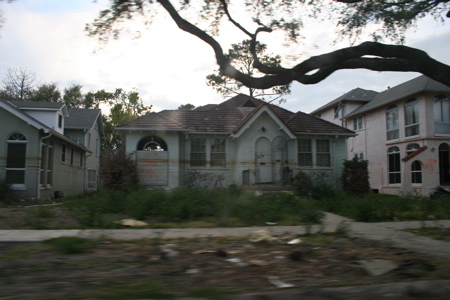
On his blog yesterday Richard Florida posted “Shades of Robert Moses” and asked “So you thought urban renewal and the destruction of neighborhoods and tearing down of historic buildings was a thing of the past. Think again: Not in New Orleans.” He first linked to a CNN article describing the violent clash yesterday at New Orleans city council (video of this is looping on CNN TV this morning) where “the members voted unanimously to allow the U.S. Department of Housing and Urban Development to demolish 4,500 public housing units.”
Much has been written about the reconstruction of NOLA and the form that reconstruction will take. When does a city lose enough of its character that it isn’t the same place? Florida also linked to a New York Times article by architecture critic Nicolai Ouroussoff who explores this and calls for caution in the renovation of a desperate city:
Arguing that the housing was barely livable before the flooding unleashed by Hurricane Katrina, federal officials have cast their decision as good social policy. They have sought to lump the projects together with the much-vilified inner-city projects of the 1960s.
But such thinking reflects a ruthless indifference to local realities. The projects in New Orleans have little to do with the sterile brick towers and alienating plazas that usually come to mind when we think of inner-city housing . Some rank among the best early examples of public housing built in the United States, both in design and in quality of construction.
On the contrary, it is the government’s tabula rasa approach that evokes the most brutal postwar urban-renewal strategies. Neighborhood history is deemed irrelevant; the vague notion of a “fresh start†is invoked to justify erasing entire communities.
This mentality also threatens other public buildings in New Orleans that can be considered 20th-century landmarks. If the government gets its way, a rich architectural legacy will be supplanted by private, mixed-income developments with pitched roofs and wood-frame construction, an ersatz vision of small-town America. That this could happen in a city that still largely lies in ruins is both sad and grotesque.
This sort of redevelopment reminds me of how downtown & inner city Detroit has been rebuilt over the years: pockets scattered here and there like patches on a devastated urban quilt. The problem with these new developments is they have a decidedly un-urban character: suburban style townhouses with garages out front surrounded by big steel fences; CVS drugstores with similarly fenced in parking lots and strip mall architecture; and wide roads where no building meets the sidewalk — all located in what was once dense urban neighbourhoods. In a city like New Orleans that is desperate for any kind of investment, watching this unfold is intensely interesting from a city-building (or un-building) point of view, but rather hard to watch from a human perspective, where the suffering of these Americans does not seem to end. Poor NOLA indeed.
Photo of New Orleans by Spacing contributor Liz Clayton taken soon after Katrina. See more here, as well as photos of the Gulf Coast here.



3 comments
I’m of a mixed mind on urban renewal.
On the one hand, I hate to see vibrant communities wiped out for someone else’s grand plan. On the other hand, was this neighbourhood really all that great to begin with? Could it not be improved, and the residents in turn reap the benefits? I’m thinking of Regent Park’s revitalization efforts. While a blank slate is an extreme response.. Katrina pretty much demands such an approach. Why should substandard and dilapidated pre-storm houses be re-hab’d at all when it is likely cheaper to build something new, modern, and up to code.. while learning from the mistakes of the past. Mistakes that included, it seems, the very buildings people want saved.
In a more ideal world, though, the built housing would be made available, or given, to residents with full ownership title. Give residents ownership of property, and it is not only less likely to fall into disrepair, but it provides an opportunity to build equity.. further lifting them out of poverty.
Except that the issue here isn’t just what’s being lost, but what’s replacing it. It’d be like Regent Park being replaced by tacky hack infill straight out of Giorgio Mammoliti country, i.e. an insult to the whole notion of “learning from the mistakes of the past”…
It’s weird: right after Katrina I’d have thought that these battles would have been fought over whether or not to rebuild flood-prone neighbourhoods at all. You can imagine locals saying “we’ve always lived there” while engineers and scientists insist a particular area is another disaster waiting to happen (especially if sea levels rise and hurricanes become more common). I haven’t heard much of those sorts of debates, though I haven’t followed New Orleans reconstruction very closely.
But in this case, everyone seems to agree something will be rebuilt in this spot, so all these strings attached to the federal money are awfully condescending. It’s vaguely like what the IMF does with developing countries: sure, you can have a big loan, but only if you restructure your economy the way we like…